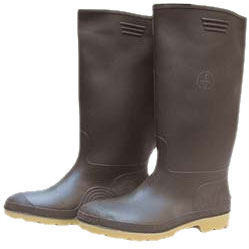Farm location
Three main factors apply here.
The first is the density of the surrounding pig population. It is safer if the region is of low pig density rather than high pig density. The nearest pig herd should be at least three kilometres away and preferably further. It is also safer if the nearest herd is small and if it is a closed herd producing weaners for rearing elsewhere rather than an open herd, such as a finishing unit, taking pigs from different sources. Abattoirs are a risk not only because slaughter pigs from different sources are held in them but also because pig trucks may pass close to the farm. The farm should be away from main roads and railways. The risk from these may be reduced by erecting barriers to baffle windborne spread.

The second factor is the nature of the terrain. Hilly wooded countryside is safer from windborne infection than flat bare land.
The third factor is the climate. Dry, sunny, warm climates rapidly inactivate infections whereas damp, cold, cloudy climates do not. It should be remembered that climates are changeable, the conditions at night may be different from the day, and prevailing winds do not prevail all the time. They may sometimes come from different directions.
Pig loading facilities
There are many good designs for pig loading facilities but basic principles apply to all. There should be a clear demarcation between truck and farm. The gate between them should be one way only so that pigs cannot run back. Neither the truck driver nor the farm staff must cross this demarcation. The loading ramp or collecting areas should be cleaned and disinfected after loading. The drainage must be so designed that the washing liquid does not run back into the farm area. Foot pedals of trucks may be contaminated and so the driver should put on clean boots before loading or unloading. Ideally the driver should also change into clean coveralls.
Other biosecurity precautions
Farm staff
When staffs are first employed it should be agreed that neither they nor the people they live with will have contact with other pigs or sources of contamination.
Peripheral farm barrier
The whole pig compound should be surrounded by a fence strong enough to deter human intruders and keep out wild animals such as wild boar and foxes. Gates in the fence should be locked when not in use. The pig building walls can act as part of the peripheral fence but there should be no open windows or gaps in the outer walls.
 Changing rooms
Changing roomsThese should be against the peripheral fence. Farm staff and visitors should undress completely in an outer room, go through a shower into an inner room where clean towels, underwear, hats, coveralls, socks and boots are provided. The showers represent the biosecurity barrier and in addition also make visitors and staff removes all their clothes.
Visitors
Visitors should be kept to a minimum and should sign a visitors’ book stating when they were last with pigs or other source of contamination. The time they have been away from these may vary from one night to a weekend depending on the type of herd.
Deliveries
Bedding should come from a safe source. Pig feed should be augured over the peripheral fence into bins. The feed delivery hose carried by the truck should not be used because it may be contaminated. A delivery hose should be kept for the farm’s use only. Preferably all machinery and instruments should be kept in the compound but if introduced should come from a clean source and be cleaned and disinfected as well as possible.
Staff food
This should only be kept and consumed in a designated staff room. Pork products should be banned.
Paths and dips
Foot dips between buildings are only effective if the disinfectant solution is kept clean. Wheel dips for vehicles are largely ineffective. Ideally, paths should be enclosed. If not, they should be cleaned and disinfected regularly.
Birds, rodents, cats and dogs
Birds should be excluded from buildings and feed bins and feed spilt around feed bins or elsewhere should be removed. Regular rodent control should be applied. Cats are sometimes kept to control rodents but they should not be allowed out of the pig compound. Guard dogs are kept in regions where intruders are likely but they must be kept inside the compound.




